We spent two days driving around Kruger National Park, one of the largest game reserves in Africa. It sprawls over more than 7,500 square miles (for those at home, that is a bit smaller than the state of New Jersey), covered in a network of tarred and dirt roads that allow visitors to drive around the park in their own cars. Thousands upon thousands of animals –including all of the “Big Five” (lions, leopards, elephants, rhinoceroses, and buffaloes) –live in the park, and many of them are easily viewable, even by complete novices like us equipped with just a Toyota Corolla and some snacks for the road.
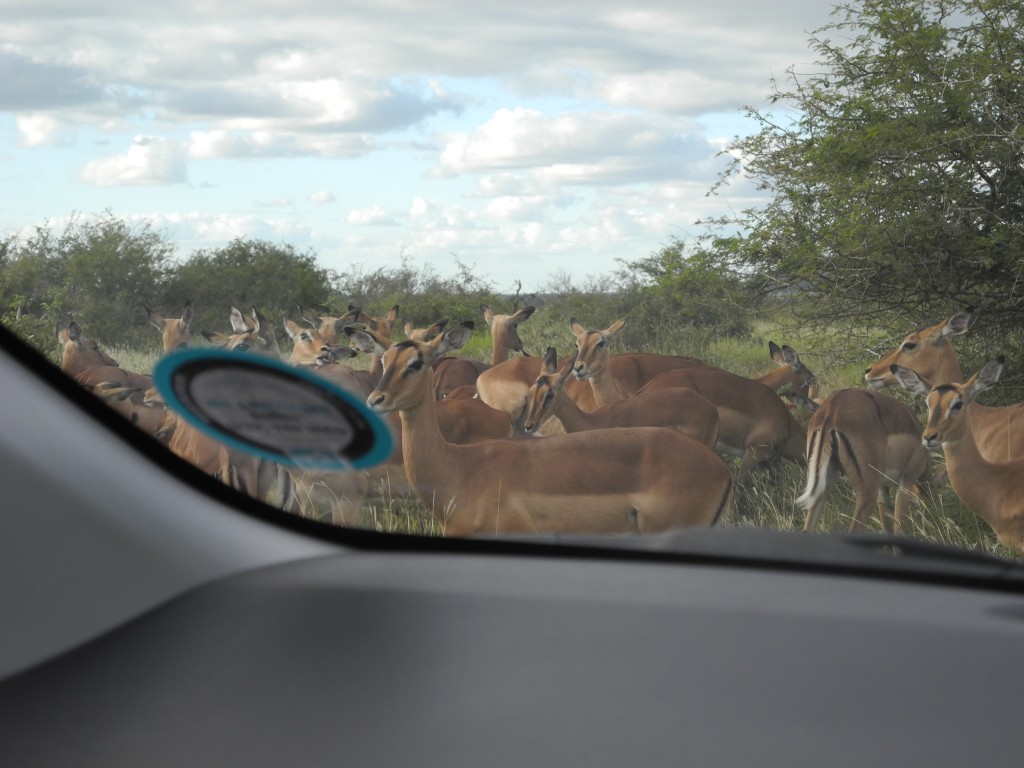
NB: Even though I’m referring to the following as a play-by-play, I’ve edited for time and interest. No one needs to know about the zillionth impala we saw, and (amazingly) even the elephants and giraffes began getting repetitive. Only the most notable sightings are listed. (And it’s still a long post! Seriously, Kruger is awesome.)
Day One
6:00 a.m. – Our alarm goes off in our tent at the Hazyview Adventure Backpackers. At this time of year, Kruger’s gates open at 6:00 a.m. The periods just after daybreak and just before dusk are when the animals are most active, and that’s when you have the best chance of spotting the animals (particularly the elusive cats), so we set out early.
7:00 a.m. – We arrive at the Phabeni Gate and pay the R248 per person conservation fee for international visitors. (The fee is per night: since we are planning on spending two days and one night in the park, we only need to pay the fee once per person.) As we were planning to stay overnight, but arrived without any reserved accommodation, we are directed to Skukuza Camp, which handles reservations for all of the rest camps in the park.
7:20 a.m. – Our first animal sighting! It’s an impala! I’m beyond excited and take a dozen pictures, ignoring Marc’s pleas, not realizing that this impala will merely be the first in a cast of thousands.
7:30 a.m. – We see our first elephant! I’m so thrilled by this elephant that I don’t even care that we can only see his back, and I almost immediately post a hastily taken picture of it on Facebook.
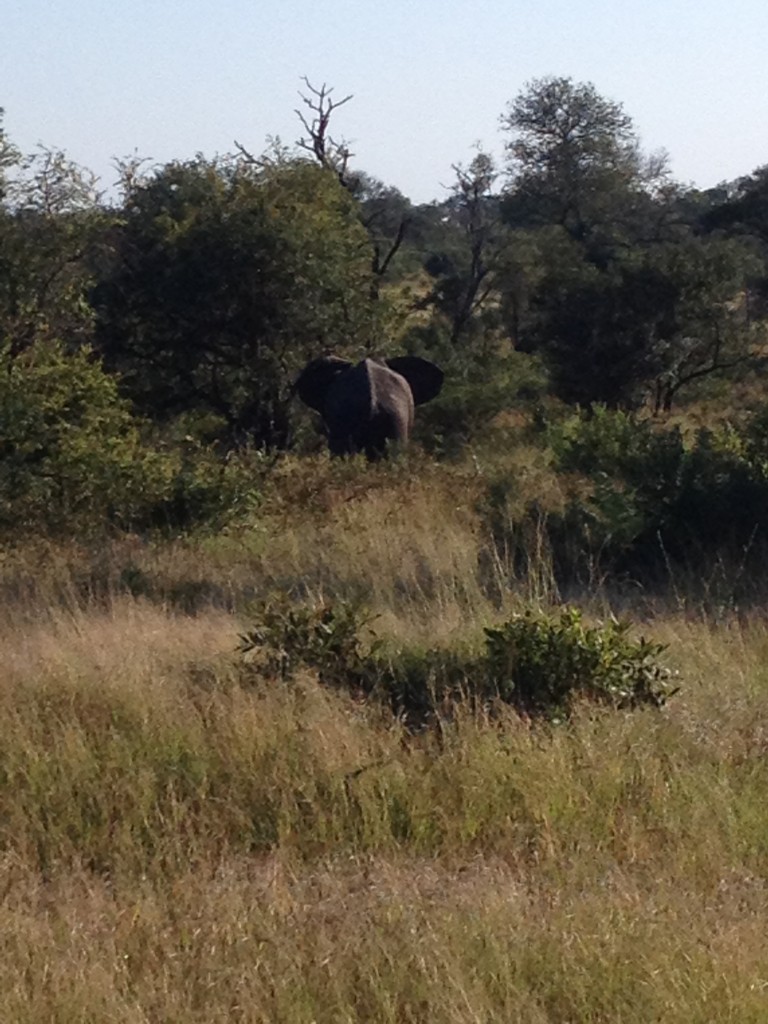
9:15 a.m. – We see some guy leaning out of his car to take photos of something on the road. We drive up slowly, and discover a little bird that looks like it was water-colored. We later identify him as a lilac-breasted roller, and he’s the first of many colorful birds we’ll see.
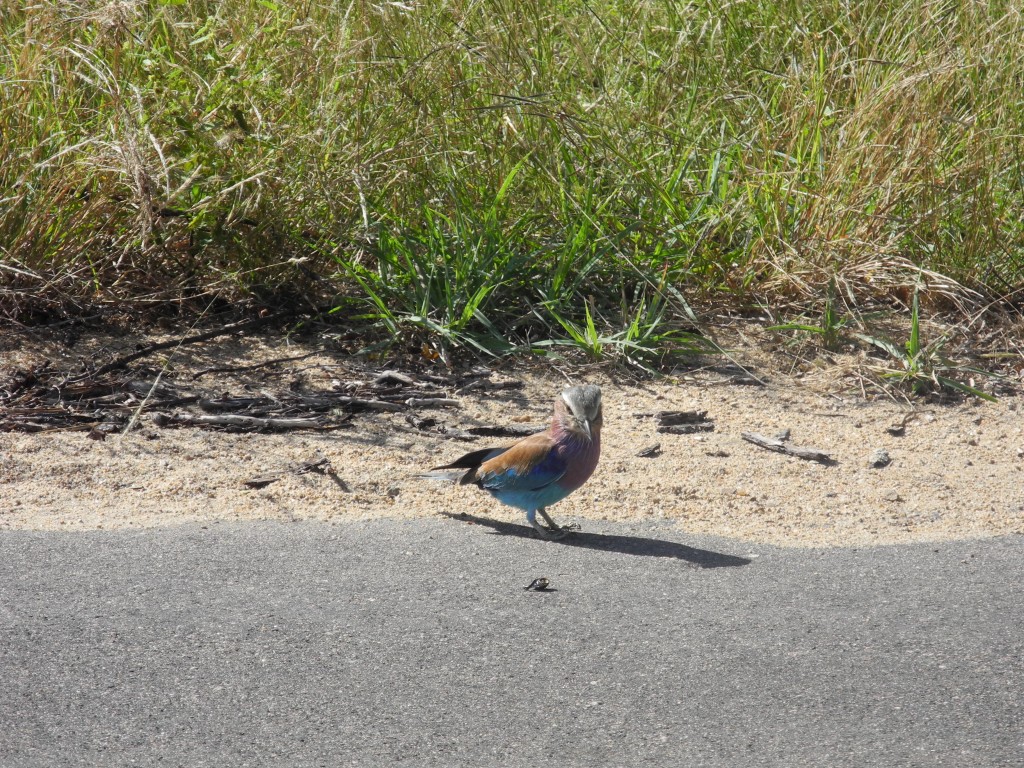
9:30 a.m. – We arrive at Skukuza Camp to make our arrangements for the night. One of the nice parts about visiting Kruger is that you can easily reserve your accommodation online in advance of your visit, but to arrange same-day accommodation, it is easier to handle it directly at the park. After discussing which camps have availability with the representative, we choose a tent in Skukuza, the largest of the rest camps, which resembles a small city (albeit one surrounded by an electric fence). We also sign up for an organized night drive safari, one of the only ways to see some of the many nocturnal animals.
10:30 a.m. – We pull over at a viewing point on the river. All available information claims that animals congregate near water. (We will later dispute this claim, as we rarely saw animals near water sources.) We see something in the water: it’s the tops of hippos. I almost mistake them for logs, but they have ears.
11:00 a.m. – We arrive at a larger water feature (a pool created by the dam), where many cars are parked. Their occupants are using binoculars to look across the water. We have no binoculars, but we squint and use the zoom lens on our cameras and identify a bunch of hippos (completely visible, not mostly hidden in water like the last hippos) across the water. Marc finds some crocodiles as well, but I’m smitten with the hippos.
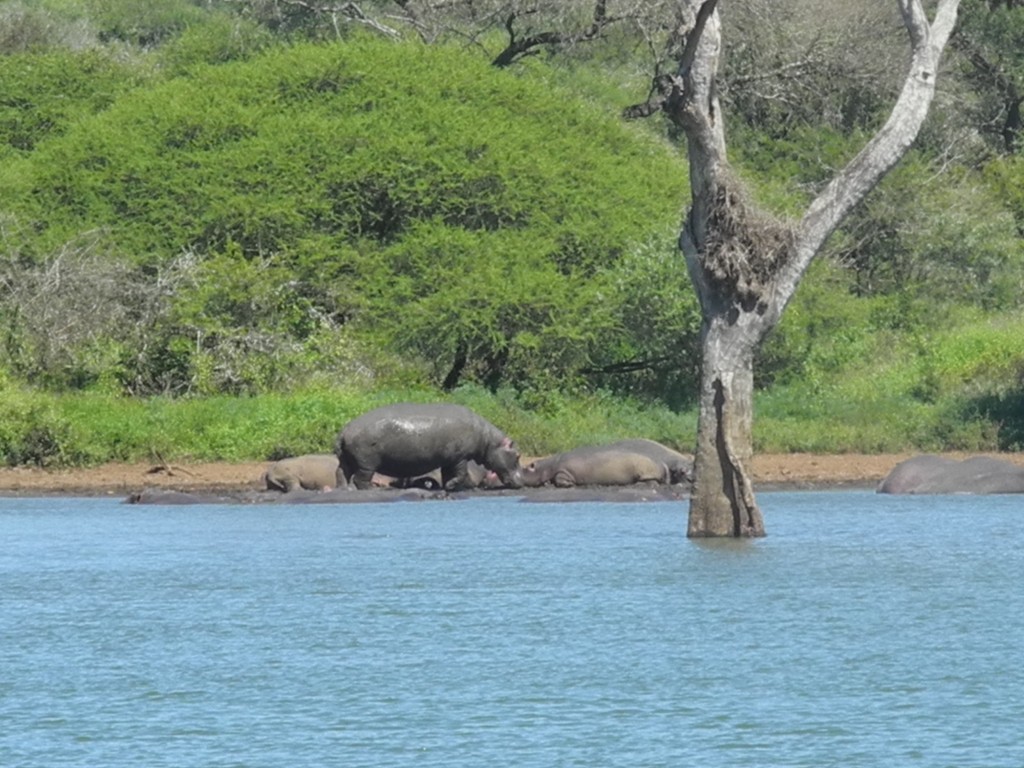
11:45 a.m. – We arrive at Lower Sabie Camp, and check the sightings board. Other people are seeing rhinos and lions; we commit the spots where these sightings have been marked to memory. We visit the park shop and purchase one of Andy and Lorraine Tinker’s maps of the park. We settle on a map which includes a useful guide that suggests good routes for seeking out certain types of animals. (Even though it’s not as useful, I want the guideless map with the color illustrations of the animals.)
12:00 p.m. – We eat lunch at my new favorite South African chain, the Mugg & Bean, at Lower Sabie Camp. This particular Mugg & Bean has a stupendous location along the river and we eat lunch overlooking the river, with a prime view of an elephant having his lunch across the way. We spy more elephants, hippos, and even a buffalo. (Our guidebook informs us that, despite buffaloes resemblance to water buffaloes – and the fact that this buffalo is, in fact, in water – they are not related to water buffaloes.)
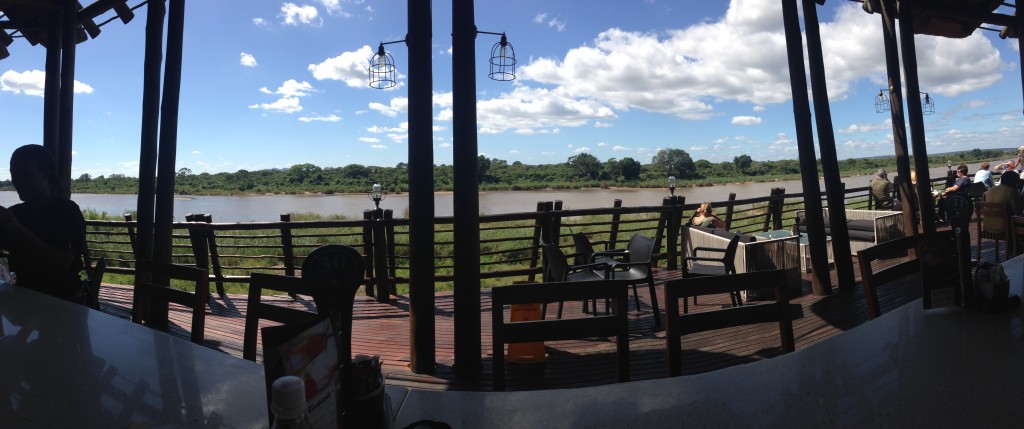
2:00 p.m. – We finally tear ourselves away from the Mugg & Bean and get back on the road. We decided to switch drivers, and I have to learn to drive on the left-hand side of the road while getting reacquainted with driving a stick-shift. I forget to worry about those things when, almost as soon as pulling out of the parking lot, we spot some elephants close to the road.
2:05 p.m. – We switch from the tarred main road to a smaller dirt road. Something lurches across the road; my first thought is, Oh my God, it’s a dinosaur! Obviously, however, as we are not in Jurassic Park, it is not a dinosaur, but a giraffe.
3:00 p.m. – Elephants want to cross the road in front of us. It’s amazing to watch them lumber across the road; I think I could watch them all day.
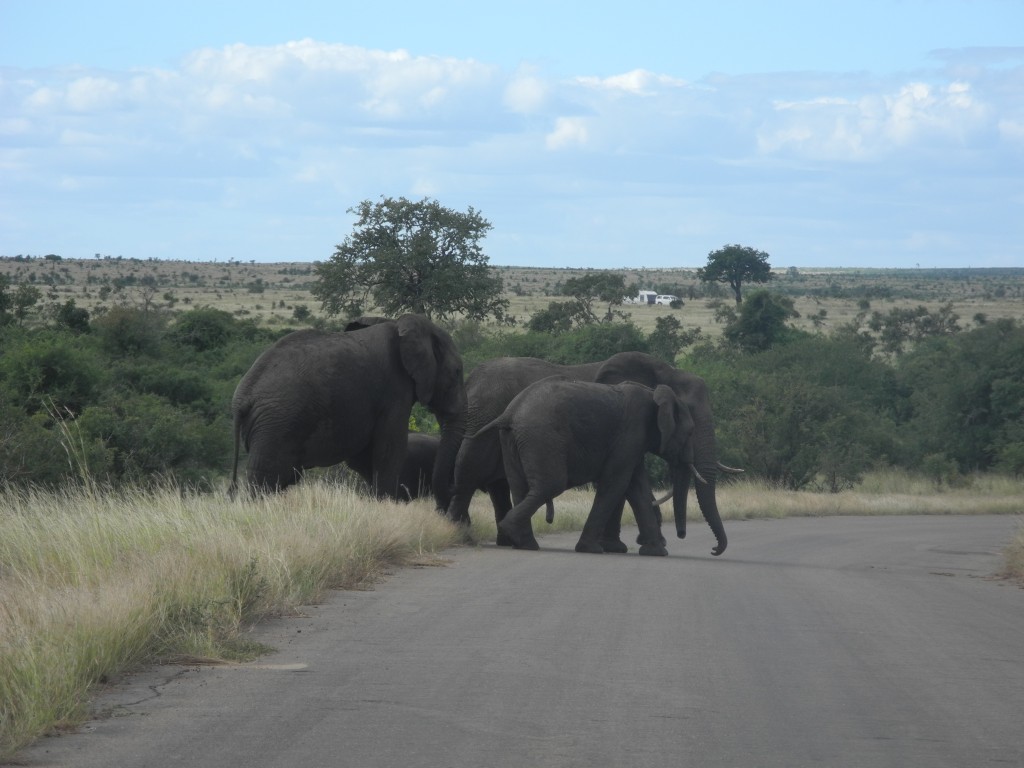
3:15 p.m. – More elephants want to cross the road! I’m still amazed by them.
3:40 p.m. – Really? More elephants are going to cross the road? Why are they moving so slowly? I begin to wonder if there’s an elephant conspiracy.
3:50 p.m. – We reach the Nkumbe viewpoint where you can disembark your car. The viewpoint is at the edge of a cliff overlooking the flat savannah several hundred feet below, in the far, far distance, we spot a wildebeest and a couple of zebra. We’ve been marking off animals as we spot them in the guide we purchased, and we check off the wildebeest and zebra. When we get back in the car, Marc takes over driving. Thank God, because this is when the animals start to go all Jumanji on us.
4:20 p.m. –As we are beginning our drive back to Skukuza Camp for the evening, a giraffe comes galloping around a blind corner just as we turn around it from the opposite direction. Both the giraffe and we put on the brakes; collision averted. Phew! We pause and let some helmeted guineafowl cross the road while we catch our breath.
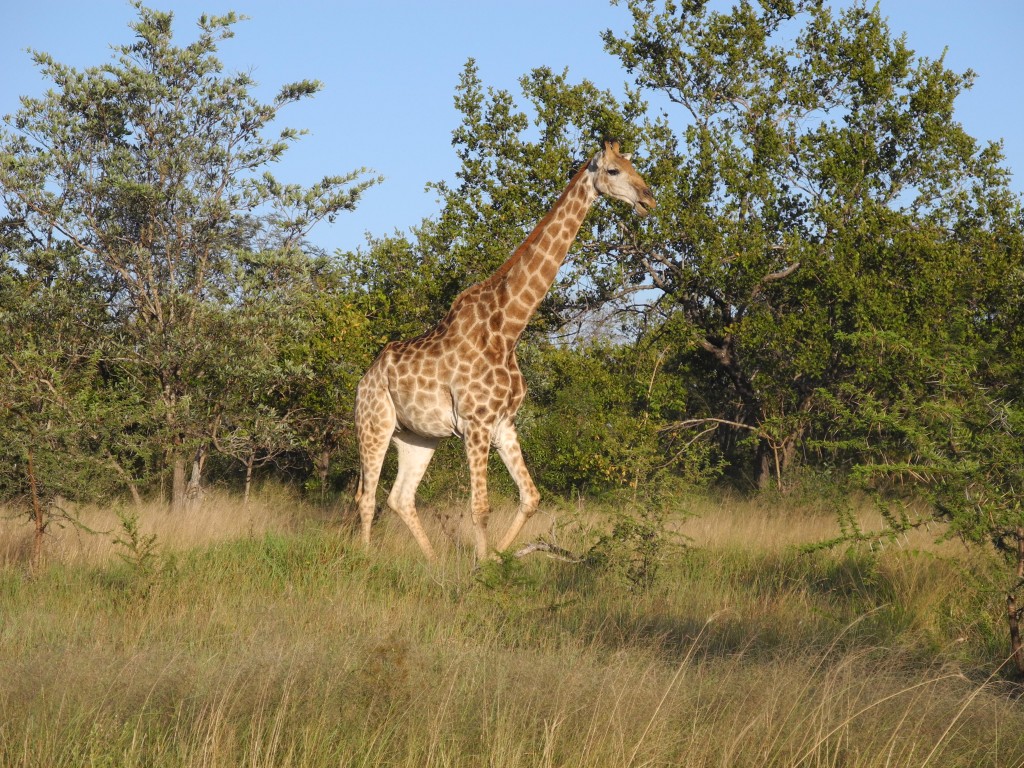
4:35 p.m. – We come across some zebras stopped in the road. We feel better about having checked them off already.
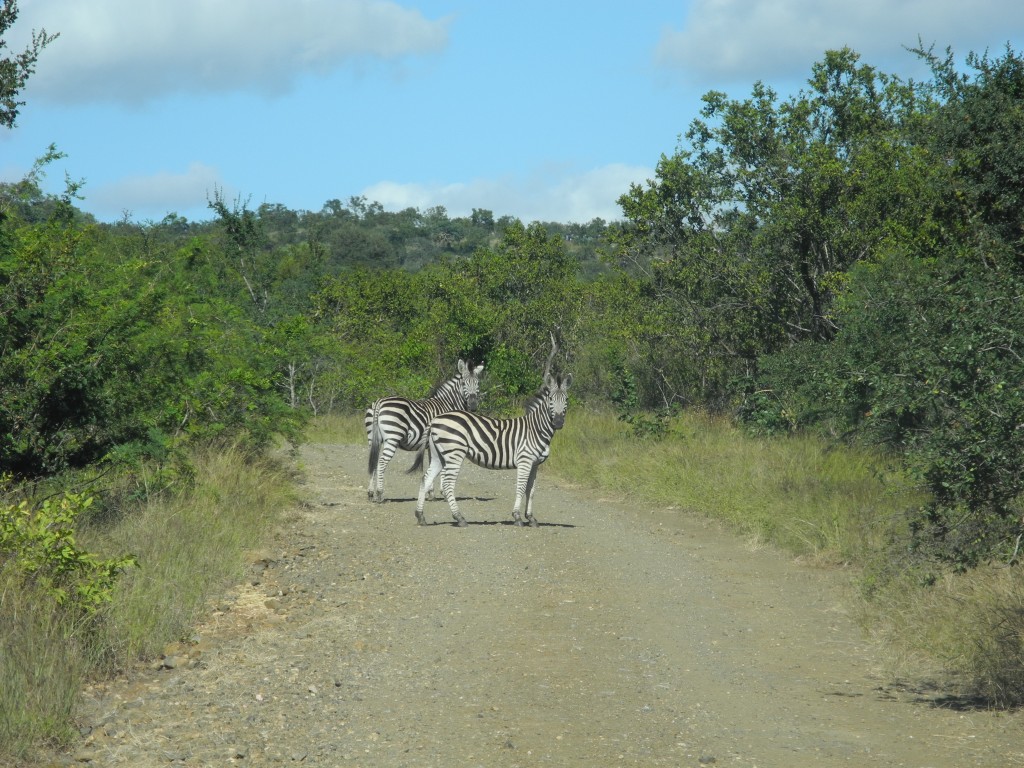
4:45 p.m. – Kruger’s gates close at 6:00 p.m. this time of year, and that’s also the time that overnight guests must be back at their camps. We consult our map and determine that we need another 40-50 minutes to get back to Skukuza Camp, which leaves us a small cushion for game-viewing. We’re feeling pretty good about the time, but then we see the elephant.
At first, we’re more amazed than worried. We round a corner and discover a huge bull elephant walking toward us, swinging a tree branch in his trunk. We stop the car to give him space, and we back up when he continues approaching us. The elephant doesn’t alter his path, he just keeps plodding down the center of the road, while we – and the cars that have piled up behind us – continue reversing.
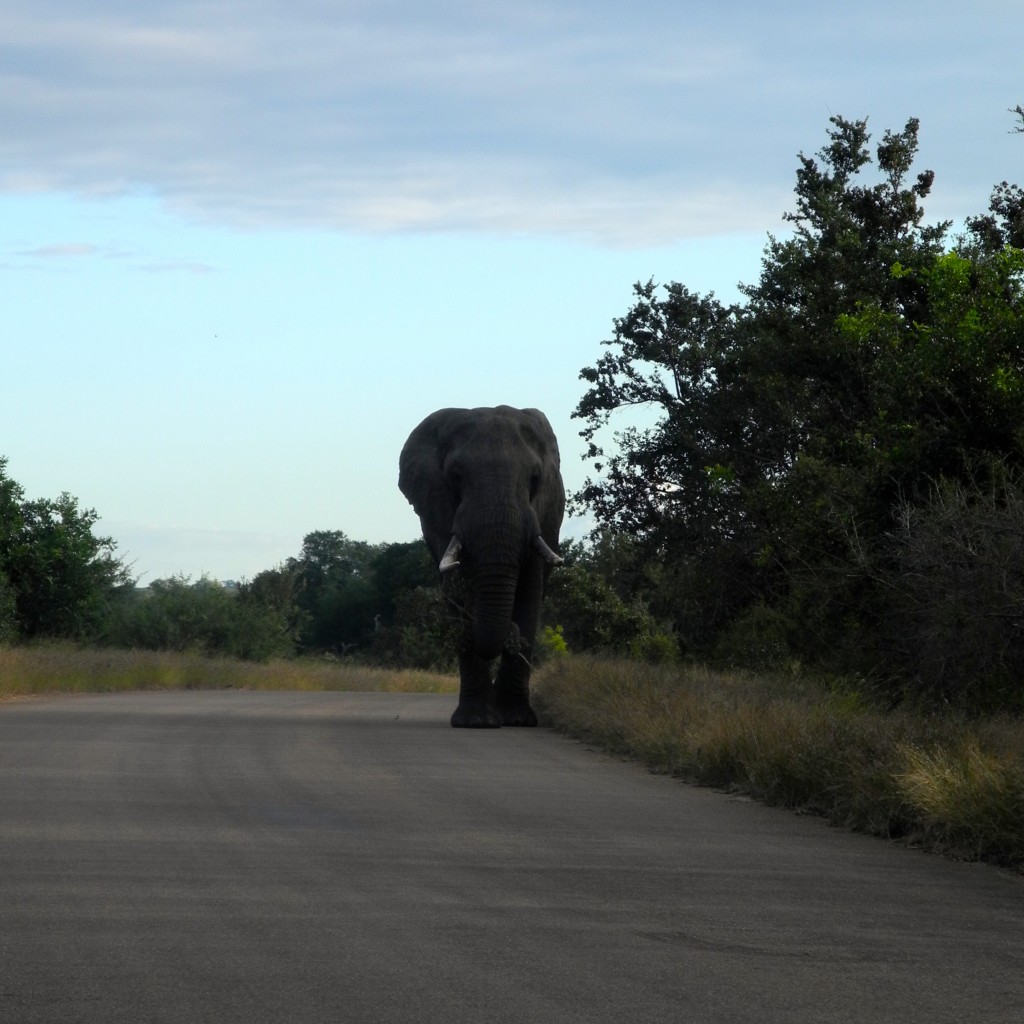
At one point, I think I see the elephant do something with his feet – it might have been a stumble, it might have been a mock charge, it might have been my imagination – and I think, oh God, is that elephant charging us? Thankfully, he doesn’t charge us, but he also doesn’t get off the road.
We consult the map, wondering if we should turn around and head another direction, but every other path will take us so far out of our way that we will definitely be late for curfew. If wait it out, we might make it on time – or be stuck there all night.
After at least fifteen minutes of the elephant ambling down the road in the opposite direction of our destination, and us driving backwards in reverse to provide a sufficient buffer, he finally stops. He remains in the road, munching a tree, so we still can’t pass, but at least he’s not driving us backwards any longer. Finally, finally, the elephant lumbers off the road and into the brush. We quickly drive by before he can change his mind.
5:57 p.m. – We slide into camp just minutes before they shut the gates, and, after we get checked in, we roll into the impressively stocked park store no less than 10 minutes before it closes for the night at 6:30 p.m. We grab some fixings for dinner: hamburger buns, cheese, warthog ham (is this some kind of sick joke? I wonder), a box of three-bean salad, and some beer, and head off to find our safari tent. It’s darker than dark, but we manage to find our tent and fix our little dinner.
7:45 p.m. – We return to the entrance of the camp for our night drive. We’re loaded into a safari vehicle, and our guide explains that sometimes night drives are slow and we won’t see any animals. He really hits that point home, and I’m disappointed before the vehicle even moves. But then! – we see a civet, a porcupine, elephants, giraffes, a chameleon, more impalas than you can shake a stick at, and lions. The lions are lazy, two of them resting in a cuddle puddle near the roadside, and a third lazing in the grass not far from the first two. The lions are sleepy, looking up at us with bleary eyes when we approach, and then putting their heads back down while we ogle them and try to take pictures that won’t turn out.
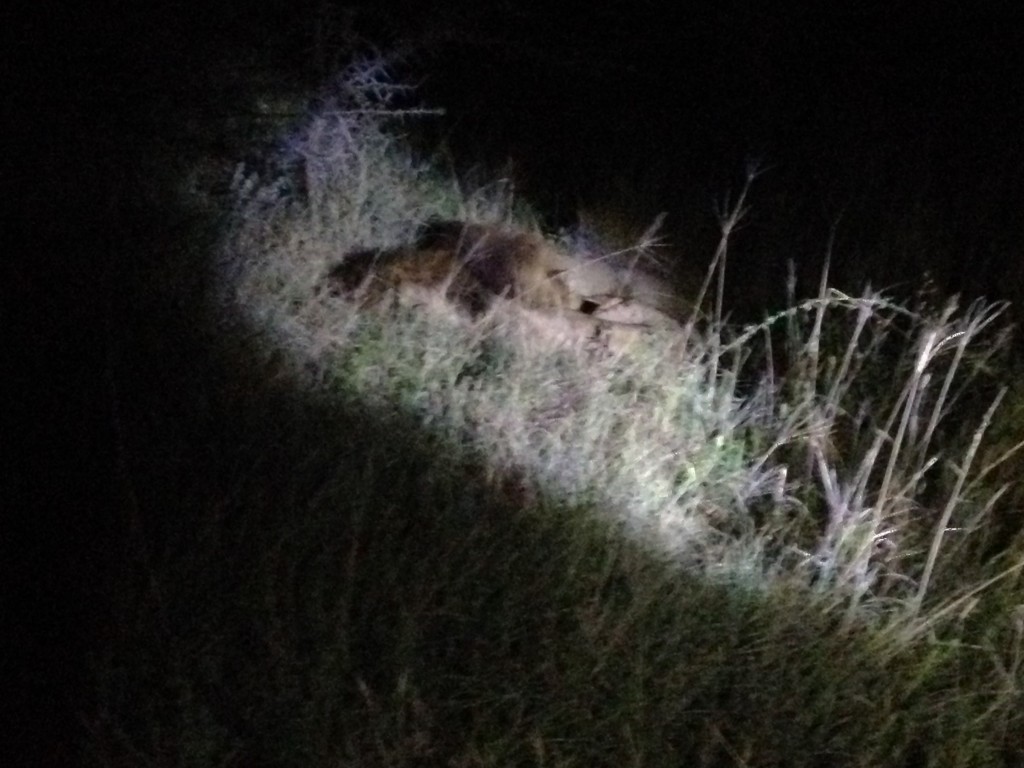
Day Two
5:50 a.m. – We wake up, engage in a fruitless search for coffee, and hit the road.
6:40 a.m. – A leopard comes strolling down the tarred road toward us, its spotted coat shining in the early morning light. I scramble to roll up the windows on the car (this rental car has power windows in the front and roller windows in the back, and I practically break my arm trying to get the back windows up), but it’s an unnecessary gesture. The leopard is totally uninterested in us. He saunters right past us, and then disappears into the brush. We reverse to try to spot him again, but he’s gone.
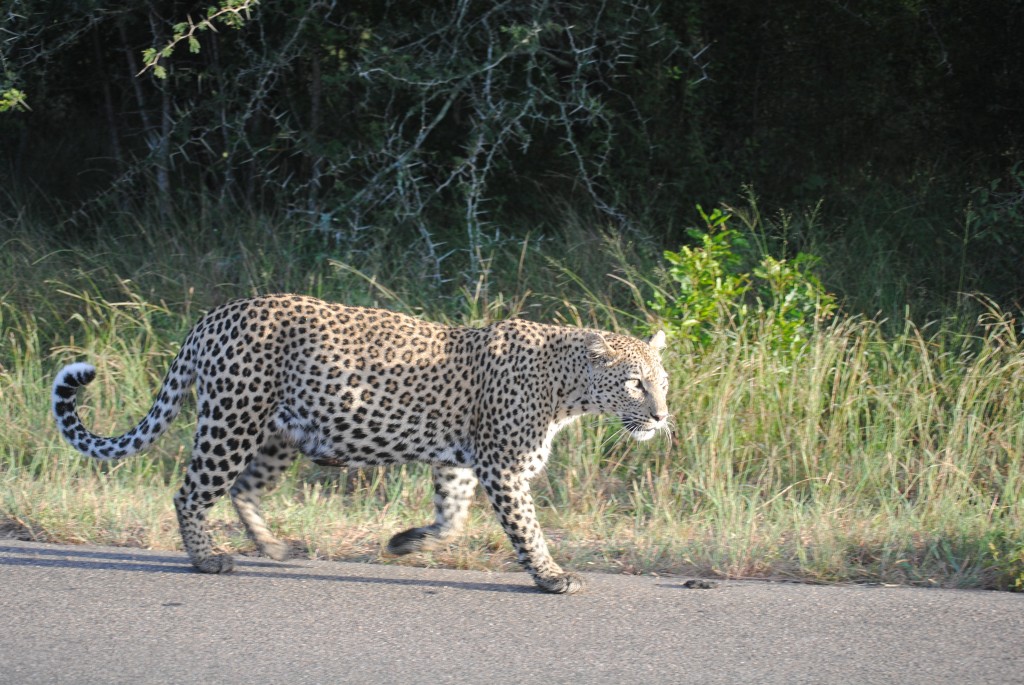
7:20 a.m. – After a giraffe sighting, a pair of spotted hyenas cross in front of us. In contrast to the leopard’s total ambivalence toward us, the hyenas stop and check us out before moving on. I’m glad the windows are still up. Just as we start moving forward again, a straggler hyena leaps out the bush and runs across the road to follow his friends.
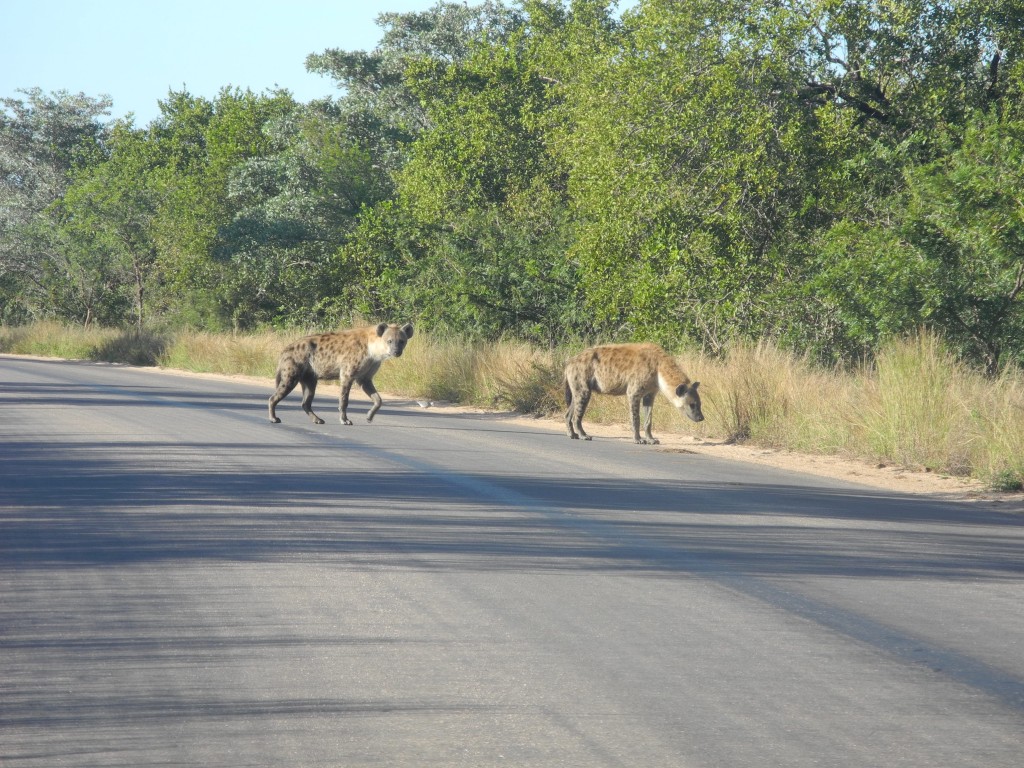
8:35 a.m. – Alerted to the presence of animals by a van (a bright orange van advertising a cleaning service in Johannesburg, no less) pulled over to the side of the road, we spot our first rhinoceroses. With relish, we check off the last of the Big Five members in our guide.
9:30 a.m. – First elephant crossing of the day. I’m skiddish about the elephants after yesterday afternoon’s encounter with the ever-approaching elephant, but this group features the cutest baby elephant I’ve ever seen.
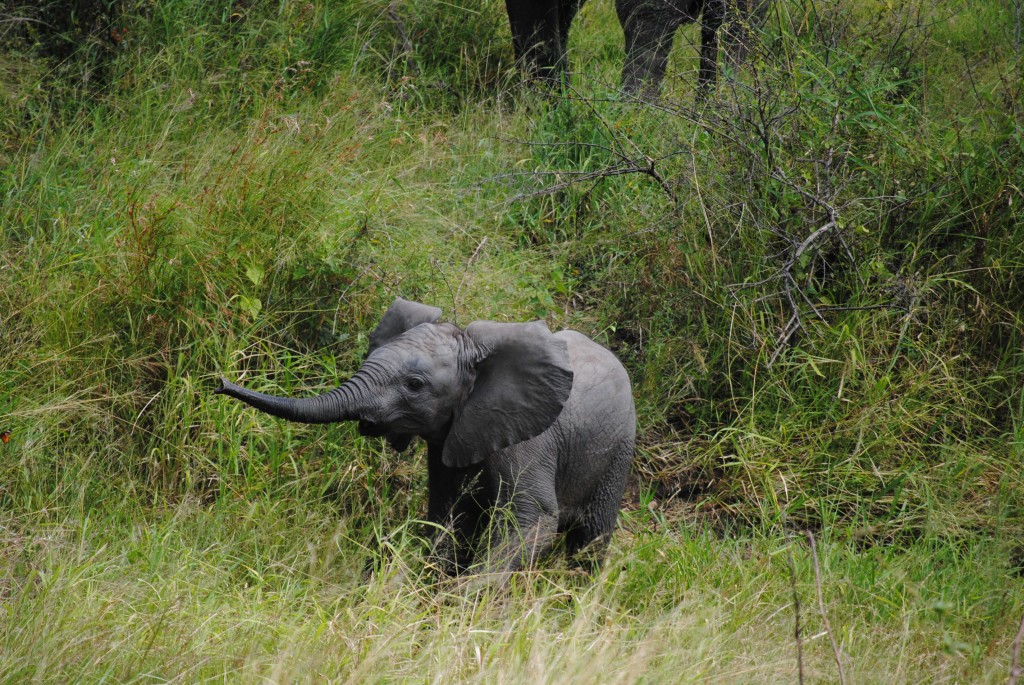
10:00 a.m. – We pause at Berg-en-Dal Camp and walked along the self-described Rhino Trail. The trail is behind a fence along the water, and we saw some stork-like birds and a breed of antelope that we had never seen before, which we later identified as waterbuck.
10:50 a.m. – We see the first warthog that wasn’t in a sandwich.
11:20 a.m. – On a dirt road, we find a giraffe standing directly in the road. There’s not enough room to pass the giraffe, so I pause the car, unsure whether we’ll need to back up. This giraffe is much more amiable than yesterday’s elephant, and moves off to the side of the road to let us pass. We drive up slowly, and he lets us get really close to him. In awe, we watch him eat the tree.
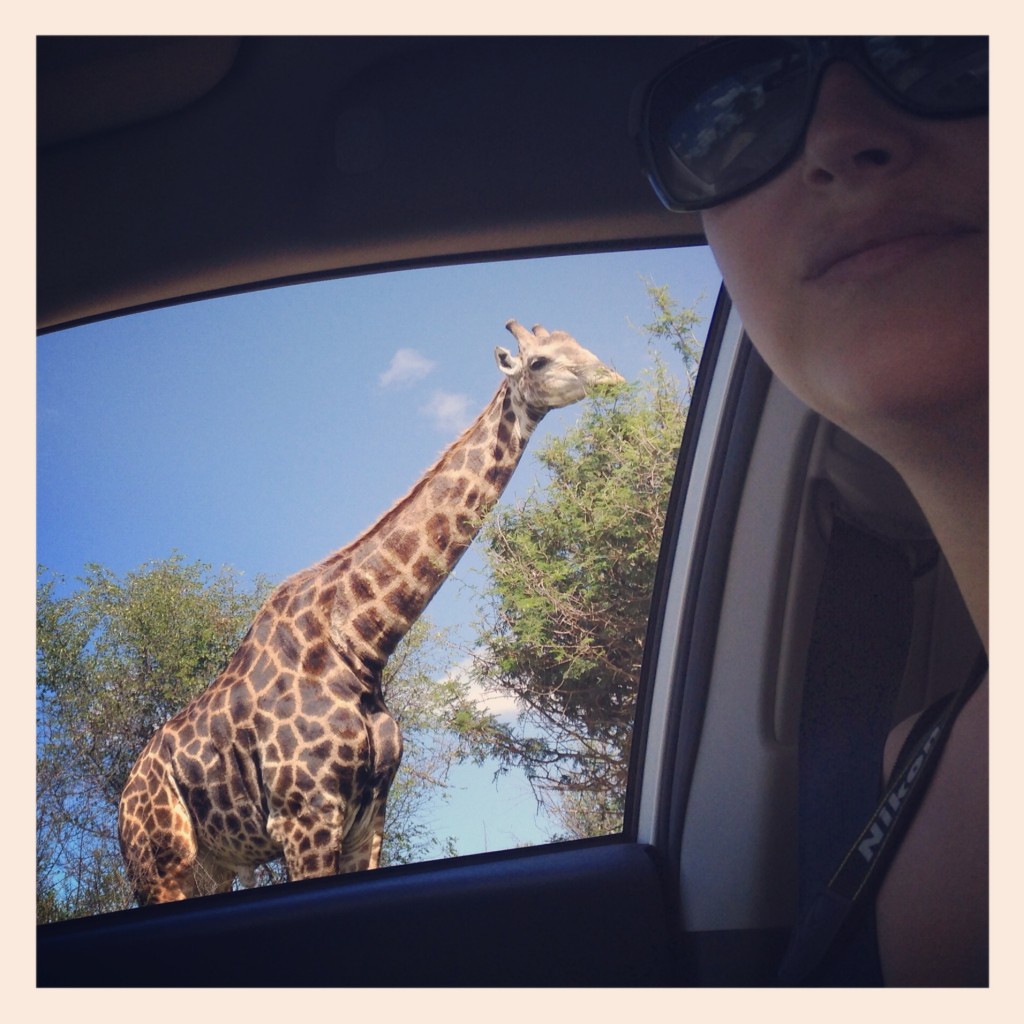
12:00 p.m. – The road we wanted to go down was closed, so we end up turning onto a road that will lead us back to where we started. We’re grumbling a little about this, but then we see them: a pair of rhinos, peacefully eating grass. We’re the only car within several kilometers on this dirt road, and we just sit and watch as they come closer and closer, eventually crossing behind our car and continuing to graze on the other side. I accidentally kill the engine while we watch them, and I’m nervous to start the car again, afraid that I’ll startle them, but they barely glance up when I start the car and drive away.
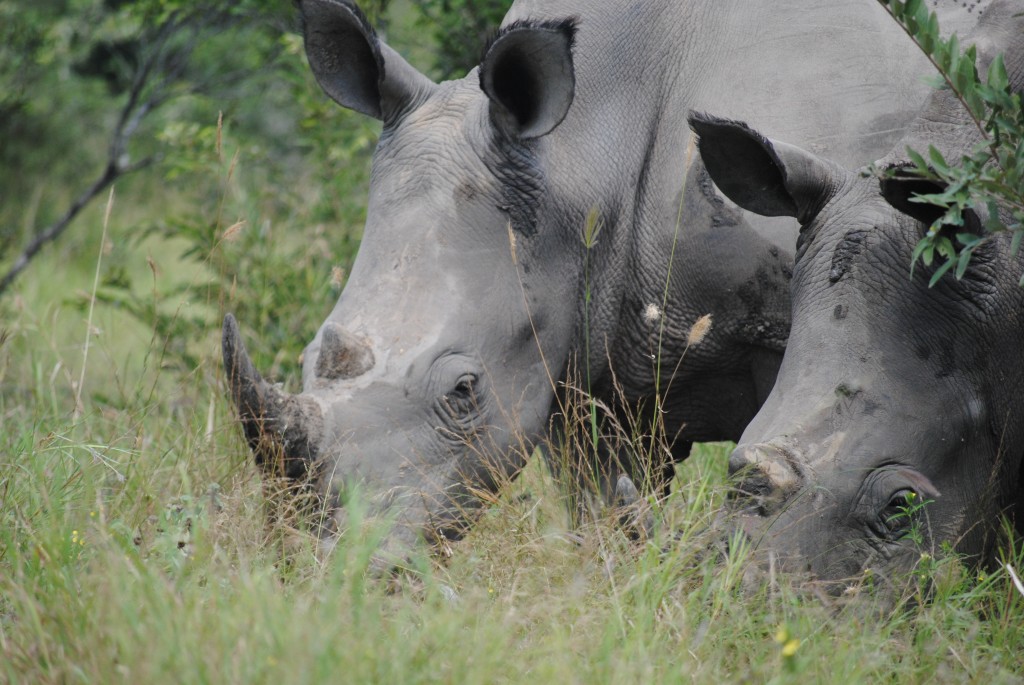
3:50 p.m. – We spot a family of elephants either fording the river or taking a bath, or possibly both. Further up the road, there’s quite a traffic jam – everyone seems to be pointing toward a tree or near the water. We can’t see anything, but someone tells us that a leopard is hiding in the brush and occasionally sits up. Ah, we think. Been there, done that. We had own private leopard sighting earlier in the morning, and so we drive on.
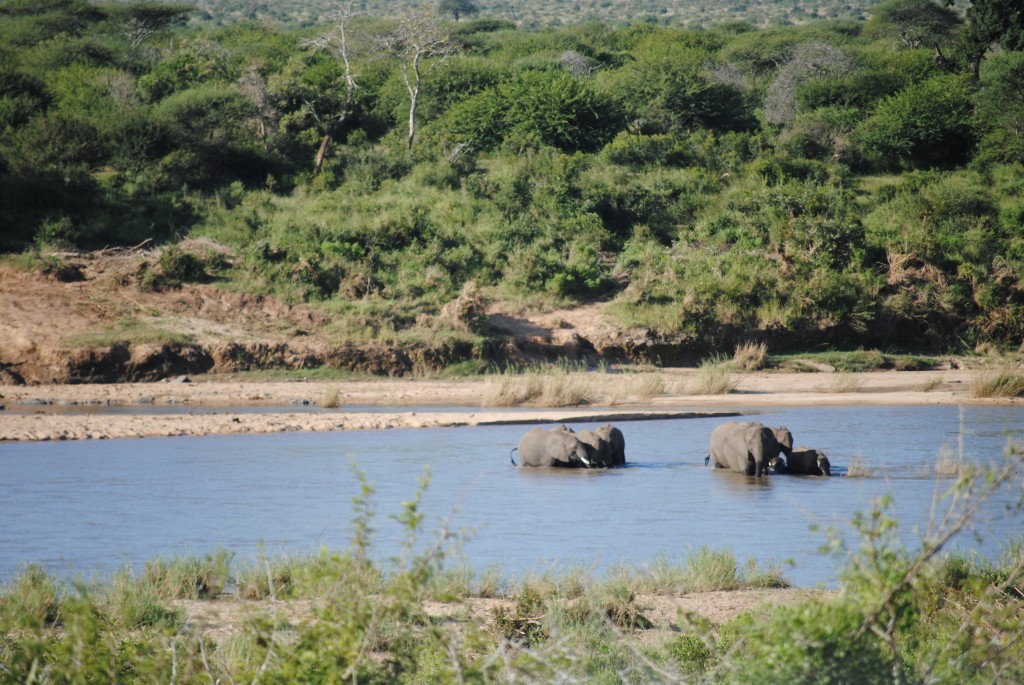
4:25 p.m. – The one member of the Big Five that we haven’t seen up close and personal is the buffalo. I’m starting to think that this won’t happen, but then we happen upon a small group of them, standing super close to the road.
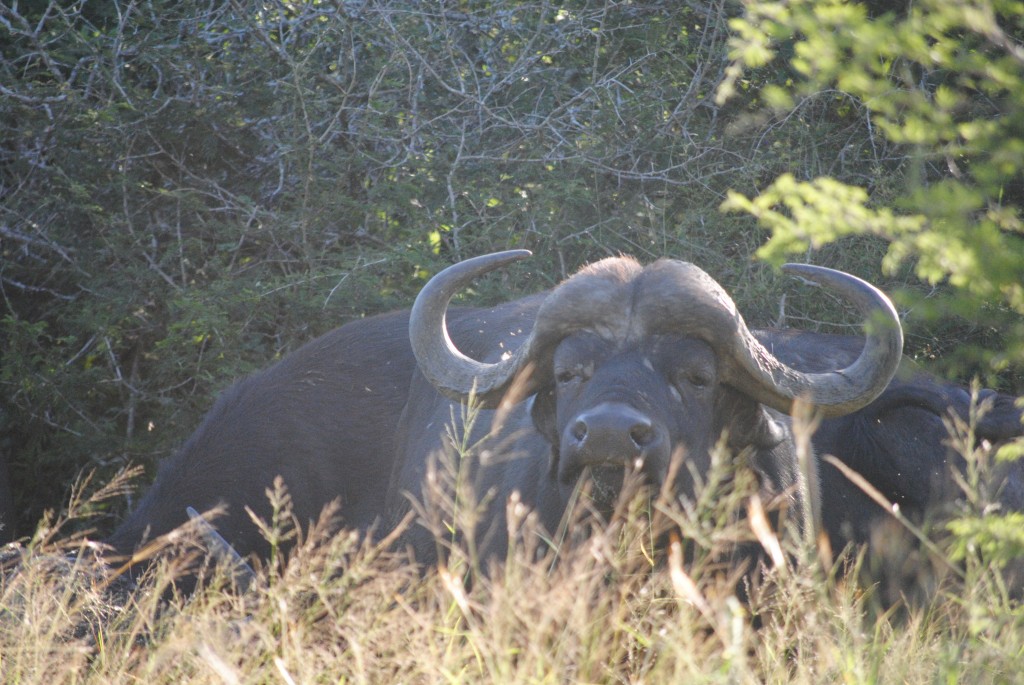
5:15 p.m. – On the wide plains near the southern end of the park, we see bunches of impalas and wildebeests. Just past the wildebeests, we see some cars pulled over, and discover that they’re watching rhinos. Past the rhino-viewers, however, is something of a traffic jam. Tons of cars are pulled over to the side, and people are hanging out of them, using binoculars to spy at something in the distance. “It’s going to kill them!” a woman exclaims. We strain and we squint, and we finally see some ears and a tawny tail twitching above the grass. It must be a lion, but we give up trying to spot it once it moves behind a tree and flattens itself against the ground. The sun is starting to go, and we don’t want to have to drive to Nelspruit in the dark.
It is worth noting here that some people deride/avoid Kruger for its overcrowding (of the tourist kind). Although we would occasionally be stopped amongst a group of cars looking at certain animals – in fact, one of the tips we read for finding the animals is to stop and look around when you see others doing the same – we would travel for stretches of over an hour at a time without seeing another human. Perhaps the situation is different during peak times and holidays, but we were alone – almost eerily so – for the majority of our animal sightings.
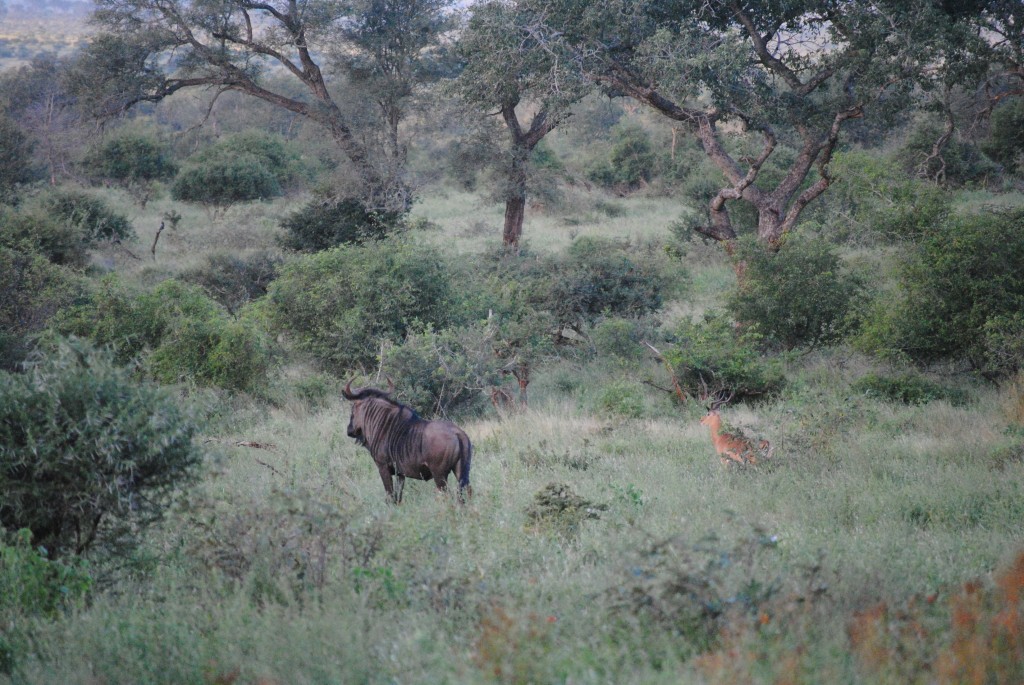
5:35 p.m. – As we’re leaving the park, we see that some warthogs have infiltrated the fence surrounding the reception area for the entrance gate. A park employee is shooting at them with a slingshot to get them to leave. It’s an amusing way to cap off two days of animal-viewing.
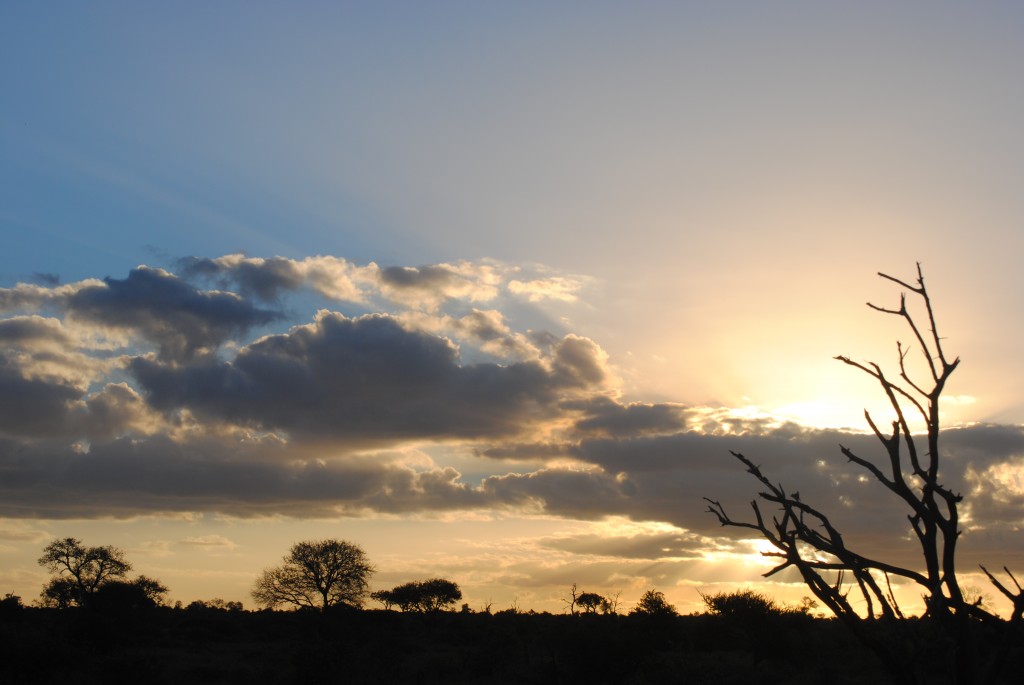

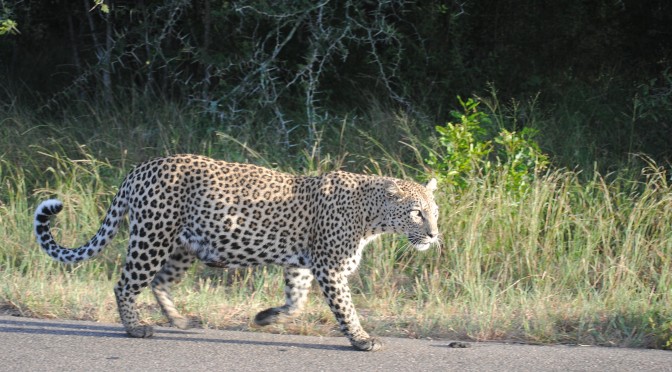

Wow Katie. Wow.
Awesome. Loved the photos and the rundown.
What an amazing adventure you are having! I would love to visit the park someday.
Amazing story and pictures!